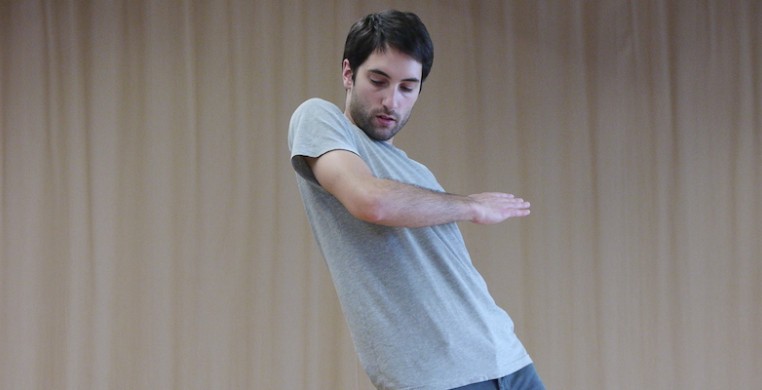In “Between Gestures,” a festival that aims to cultivate a stronger connection between the Chicago dance community and European contemporary dance, eight French and German dancers and choreographers bring their work in styles ranging from voguing to butoh to venues across the city. The Dance Center at Columbia College Chicago presents Pol Pi on Oct 24 and Noé Soulier on Oct 25, two choreographers who transform the philosophies of 20th century postmodern and contemporary dancers through academic research and the adaptation of historical dance to present-day performance.
Soulier’s “Movement on Movement” revisits a theme he has explored in multiple works, this time combining steps derived from William Forsythe’s digital dance lecture “Improvisational Technologies” with spoken text to investigate the limitless possibilities that exist within the body. By discussing dance in a way that draws connections to everyday movement, Soulier hopes to give audiences a visceral performance experience while demonstrating the potential for reorganizing existing dances within the body.
“What can be said about movement, through movement, is slightly different than what can be said about movement through speech,” Soulier said through a phone interview from Paris. “In choreographic practices from ballet to today there have been so many ways of approaching movements. This work allows us to experience more, to broaden the ways in which we can perceive movements.”
Soulier mentioned how much of the research in his work can be traced back to the artists of the Judson Dance Theatre era in New York City. He noted the significance of performing “Movement on Movement” in the United States where “this question of how movement affects us,” he said, “or how do we think through movement, or what are the meanings of dance and daily movements” was at the forefront of many artists’ work.
In a similar investigation of the legacy of movement, Pi’s work “ECCE (H)OMO” transforms the original choreography of German dancer and choreographer Dore Hoyer’s “Afectos Humanos” (a series of solos) to determine what it means, feels and looks like to embody someone else’s personal choreography as well as movement that transcends history.
“I’ve never thought much about what this piece means to me, but I think it opened many things for me in terms of thinking about the relationship of history to past dance,” Pi said in a phone interview from France. “I think that trying to get close to these dances, it’s very visible the difference between what these dances were in [Hoyer’s] history, her body, her technique—where she came from and where I come from.”
Also a classical musician, Pi said the idea of performing the work of another artist felt very natural, but in practice, Pi realized “it’s such a complex thing to work with somebody else’s dance and somebody else’s body with all these questions of who can embody what.”
In adapting these solos for his own body, Pi said he learned Hoyer’s creative habits and then made decisions on when to follow those habits and when to deviate from them, transforming some of the meaning of the work. In doing this, he asks: “How can working with dance history also be about creating identities? What does it mean to do somebody else’s dance?”
Between Gestures—presented in part by Goethe-Institut Chicago and the Consulate General of France in Chicago with two cultural institutions in France and Germany—also features the performances, dialogues and masterclasses of six other artists. Both Soulier and Pi are teaching free classes. A full program of the festival’s events can be found at the Between Gestures website.
Building off the festival’s mission of fostering connections between European and Chicago artists, Pi (who has never performed in the United States before) notes the importance of touring for choreographers to see how their work resonates with broader audiences and for audiences to understand the work of international artists live.
“I feel that even though we live in this world where everything is so connected, there is not so much exchange. There are just a few artists that tour, but for the rest we have the feeling that we know what is happening, but it’s not really true. And of course, what we do is live, so it’s very very different to see something in a video and then to really be there,” Pi said. “How will this kind of work or this kind of approach resonate in the United States?”
“I’m very curious at least to see how it’s going to be to perform in the States,” said Pi.
--
“ECCE (H)OMMO” occurs Thursday, Oct 24 and “Movement on Movement” occurs Friday, Oct 25 at the Dance Center at Columbia College Chicago, 1306 S. Michigan Ave. Tickets can be found by clicking the event link below.

